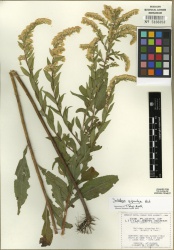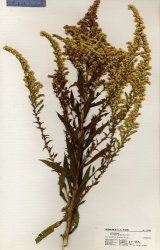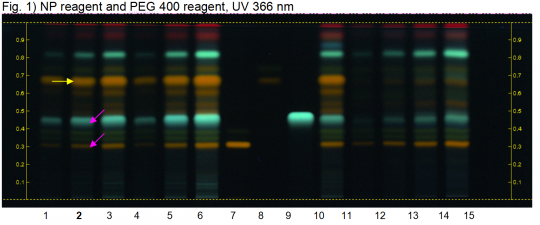Solidago gigantea (aerial parts)
(Nomenclature updated) |
(add askbox) |
||
| (2 intermediate revisions by one user not shown) | |||
| Line 1: | Line 1: | ||
| + | {{DISPLAYTITLE:''Solidago gigantea'' (aerial parts) }} {{askbox|herb=''Solidago gigantea''}} | ||
=Nomenclature= | =Nomenclature= | ||
| Line 11: | Line 12: | ||
|notes= }} | |notes= }} | ||
| − | = | + | =Botanical Voucher Specimen= |
| − | + | ||
| − | = | + | {{Media2 | cat=Voucher |
| − | + | ||
| − | = | + | | source=MOBOT, Tropicos.org |
| + | | mainimage=Solidago_gigantea_Tropicos_89552.jpg | ||
| + | | companyimage=TropicosLogo.gif | ||
| + | | companyURL=http://www.tropicos.org/Image/89552 | ||
| + | | reference=Tropicos.org. Missouri Botanical Garden. 26 Mar 2014 <http://www.tropicos.org/Image/89552> | ||
| + | |||
| + | | source2=MOBOT, Tropicos.org | ||
| + | | image2=Solidago_gigantea_Tropicos_100014590.jpg | ||
| + | | companyimage2=TropicosLogo.gif | ||
| + | | companyURL2=http://www.tropicos.org/Image/100014590 | ||
| + | | reference=Tropicos.org. Missouri Botanical Garden. 26 Mar 2014 <http://www.tropicos.org/Image/100014590> | ||
| + | |||
| + | | }} | ||
| + | |||
| + | |||
| + | =Organoleptic Characteristics= | ||
| + | |||
| + | =Macroscopic Characteristics= | ||
| + | =Microscopic Characteristics= | ||
| + | |||
| + | =High Performance Thin Layer Chromatographic Identification= | ||
{{HPTLC | source=HPTLC Association | {{HPTLC | source=HPTLC Association | ||
| companyimage=HPTLC-assoc-Logo-farbig-Text-schwarz-300x47.png | | companyimage=HPTLC-assoc-Logo-farbig-Text-schwarz-300x47.png | ||
| Line 59: | Line 78: | ||
| }} | | }} | ||
| − | = | + | =Supplementary Information= |
| − | + | =Sources= | |
| − | + | <references /> | |
Latest revision as of 21:19, 2 June 2014
Contents |
Nomenclature
Solidago gigantea Aiton Asteraceae
Syn. Solidago serotina Aiton
Standardized common name (English): early goldenrod
Botanical Voucher Specimen
|
|
|
Organoleptic Characteristics
Macroscopic Characteristics
Microscopic Characteristics
High Performance Thin Layer Chromatographic Identification
|
Giant goldenrod herb (aerial parts) (Solidago gigantea) Lane Assignments Lanes, from left to right (Track, Volume, Sample):
Reference Sample(s) Reference: Individually dissolve 1 mg of rutin and 1 mg of chlorogenic acid each in 1 mL of methanol. Optional: dissolve 1 mg of quercitrin in 1 mL of methanol. Stationary Phase Stationary phase, i.e. Silica gel 60, F254 Sample Preparation Method Sample: Mix 500 mg of powdered sample with 5 mL of methanol and sonicate for 10 minutes, then centrifuge or filter the solutions and use the supernatants / filtrates as test solutions. Derivatization reagent: 1.) NP reagent, Preparation: 1 g of natural products reagent in 200 mL of ethyl acetate; 2.) PEG reagent, Preparation: 10 g of polyethylene glycol 400 in 200 mL of dichloromethane, Use: Heat plate for 3 min at 100°C, then dip (time 0, speed 5) in NP reagent, dry and dip (time 0, speed 5) in PEG reagent. Detection Method Saturated chamber; developing distance 70 mm from lower edge; relative humidity 33% Other Notes Images presented in this entry are examples and are not intended to be used as basis for setting specifications for quality control purposes. System suitability test: Rutin: orange fluorescent zone at Rf ~ 0.30; Chlorogenic acid: green fluorescent zone at Rf ~ 0.48. Identification: Compare result with reference images. The fingerprint of the test solution is similar to that of the corresponding botanical reference sample. Additional weak zones may be present. The chromatogram of the test solution shows an orange zone at Rf ~ 0.30 corresponding to reference substance rutin and a green zone at Rf ~ 0.48 corresponding to chlorogenic acid (pink arrows). Above it there are several faint brown zones and an intense brown zone (Rf ~ 0.67) at the position of quercitrin (yellow arrow). A green zone is seen at Rf ~ 0.82. Test for other species: European goldenrod herb does not show an intense brown zone at Rf ~ 0.67.
|
Supplementary Information
Sources
- ↑ MOBOT, Tropicos.org http://www.tropicos.org/Image/89552
- ↑ MOBOT, Tropicos.org http://www.tropicos.org/Image/100014590
- ↑ HPTLC Association http://www.hptlc-association.org/


